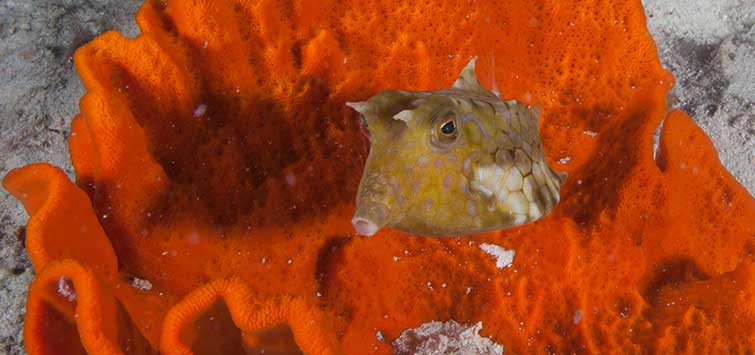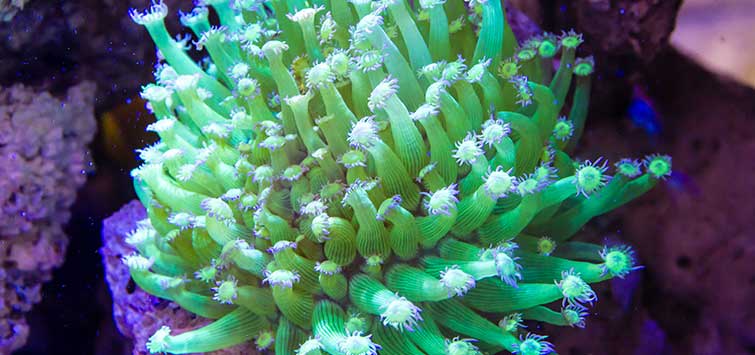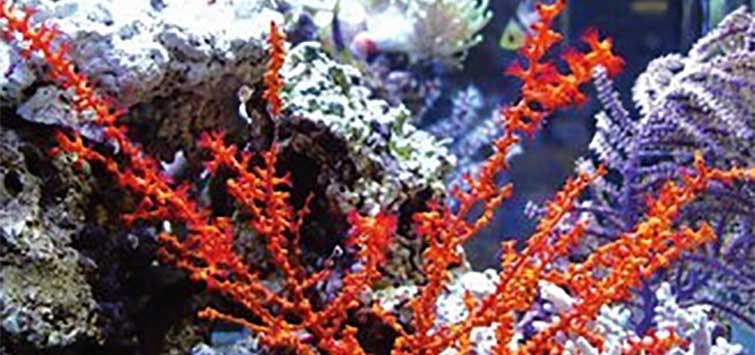Stylissa cf. flabelliformis
Author: Bob Goemans
Common Names: Orange paddle sponge, orange fan sponge, orange ear sponge
Phylum: Porifera
Class: Demospongiae
Order: Halichondrida
Family: Axinelidae
Range: Western Tropical Pacific Ocean
Natural Environment: This sponge is usually found encrusting various substrates on coastal rocky shelf areas where water currents are fairly swift, and it is found with its flat side facing into the current.
Water Requirements: Calcium 380 to 430 ppm, alkalinity 3.5 meq/l, pH 8.1 to 8.2, specific gravity 1.025, and a temperature range of 72 to 83 degrees Fahrenheit (22 to 28 degrees Celsius).
Captive Care
Feeding
Stylissa flabelliformis is a non-photosynthetic filter-feeding animal, and it requires shaded areas receiving excellent water movement. This sponge requires at least one daily feeding of live and/or preserved commercial phytoplankton and zooplankton products, or of animal and plant powders that produce suspended products in the bulk water. Even though it prefers somewhat nutrient-rich surroundings, it will not tolerate algal growth.
Tending to Needs
Generally, almost all sponges are difficult to maintain long term in captivity without special attention to their individual needs, and this beautiful species is no different. It should be kept in systems designed to meet its needs, not simply as a colorful addition to a new reef tank, or even that of a thriving reef system, if its nutritional needs cannot be met. Occasionally stirring of the substrate/sediment/sandbed will also help small particulate matter (detritus) to enter the aquarium's bulk water, somewhat helping to provide some nourishment.
Notes
Simple Creatures
Sponges are the simplest of multicellular creatures. THere are over 15,000 species. Most are found in marine waters, and they vary in size, shape, and color. They posses no nervous, digestive, nor excretory systems, and they feed by filtering suspended bacteria and fine detritus. Strong water movement is vital to almost all; not only for carrying food to these sessile creatures, but also to carry waste/unused matter away. In fact, it is said a sponge the size of a baseball can filter 50 gallons of water per hour! Most do best only in low-light area and where currents are quite swift.
Reproduction and Preservation
Each sponge has both female and male reproduction capabilities. Cutting a piece from the healthy tissue and relocating it in another area can form new colonies. Bear in mind the new specimen should not be exposed to air during the procedure, as that may kill it. In fact, when purchasing new specimens, they should be bagged under water, i.e., never lifted out of the water. Nor should any air or oxygend be added to the bag, as it may become trapped in the animal's tissue during transport and lead to its early demise. They are not too sensitive to temperature changes, yet sudden changes in salinity may have drastic effects.
New specimens should not contain any gray or white tissue, which is usually a sign of dying or dead tissue. HOwever, it is possible to cut that section out--under water, of course.
And finally, after noting several different identifications and places of origin for this species, I asked two noted marine biologists and divers, Vincent B. Hargreaves and Julian Sprung, for their thoughts as to its correct scientific name and origin.
Origin
Dr. Hargreaves notes that he has personally seen this exact-looking species in numerous dives around the Philippines and that it's also available from the Maldives, and has identified it as noted above. He also mentions this species is easily confused with Clathria prolifera and Pseudaxinella durissima from Indonesia. He goes on to say that a similar-lloking sponge does not appear in the Tropical Atlantic.
Julian mentioned he used the Guide to Sponges in New Caledonia, which contained a photograph of it. However, he doubted the Clathria identification because he is familiar with other Clathria species. Yet he was unable to give me a definitive answer, other than to say that he doesn't believe this sponge is Clathria, nor does he think it is Stylissa. His guess is that it's probably a species of Axinella, but it may belong to the genus Reniochalina.
I appreciate both responses helping me to narrow down what sponge this is. Obviously more research is needed for an exact identification, but the husbandry is the same, whatever the species turns out to be.

.png?h=595&iar=0&w=2781&hash=5FD5E69473BCC22199FBFA2FB71B6033)



